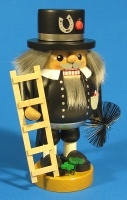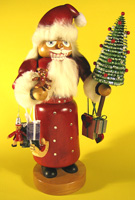German Wooden Nutcracker
German Wooden Nutcracker
 From the time that man and nuts have co-existed nutcrackers or "nussknackers" have been along to assist man in their endeavor to break open hard shells and access the meaty goodness of the nut. These nutcrackers have varied in materials, mechanical makeup and function, depending on what resources existed to use in the implement and which type of nut was being cracked. Some of the earliest nutcrackers were created out of stone. A few of these stone nutcrackers are very elaborate. Some operate by a "banging" or screwing action while others use pressure or a lever. Today, most nutcrackers come in the form of pressure crackers, where the individual grips two jointed bars and squeezes the nut between them, or lever crackers.
From the time that man and nuts have co-existed nutcrackers or "nussknackers" have been along to assist man in their endeavor to break open hard shells and access the meaty goodness of the nut. These nutcrackers have varied in materials, mechanical makeup and function, depending on what resources existed to use in the implement and which type of nut was being cracked. Some of the earliest nutcrackers were created out of stone. A few of these stone nutcrackers are very elaborate. Some operate by a "banging" or screwing action while others use pressure or a lever. Today, most nutcrackers come in the form of pressure crackers, where the individual grips two jointed bars and squeezes the nut between them, or lever crackers.
The lever nutcracker uses technologies of Archimedes, a Roman mathematician from the third century. Archimedes understood physics and used balances, screws and levers as war machines. This technology was revolutionary at flipping or crushing boats in a wench, and quickly became adapted to de-shelling nuts. Early nutcrackers, of the lever and screw variety used metals of iron or brass, fastened either with leather straps or with bolts. These began as simple, functional pieces, but in time, craftsmen began to carve shapes mostly of animals into the metals.
 Before the 15th century, the Erzgebirge region of Germany was mostly unpopulated due to its densely forested mountainous terrain. This soon changed though with the discovery of silver and tin ores as well as other mineral deposits found throughout these mountains. Today the Erzgebirge region of Germany and Czech Republic referred to as the "Ore Mountains." Some of the nutcrackers found in this region were made of metal, but others made use of the vast wood supplies that the forests provided. During the summer months, these mountains were busy with miners working hard. In winter months, however, work was slowed due to snow, rains and colder temperatures, making mining difficult before modern technology lengthened the workday. In the winter, the miners would occupy themselves making woodcrafts, utilizing the rich resource of the forests around them. German miners would whittle toys, German candle pyramids, smokers and figurines. It was not long before artisans began to adapt the plain wooden lever-action nutcracker, by whittling them into the shapes of soldiers, monks, kings or professions.
Before the 15th century, the Erzgebirge region of Germany was mostly unpopulated due to its densely forested mountainous terrain. This soon changed though with the discovery of silver and tin ores as well as other mineral deposits found throughout these mountains. Today the Erzgebirge region of Germany and Czech Republic referred to as the "Ore Mountains." Some of the nutcrackers found in this region were made of metal, but others made use of the vast wood supplies that the forests provided. During the summer months, these mountains were busy with miners working hard. In winter months, however, work was slowed due to snow, rains and colder temperatures, making mining difficult before modern technology lengthened the workday. In the winter, the miners would occupy themselves making woodcrafts, utilizing the rich resource of the forests around them. German miners would whittle toys, German candle pyramids, smokers and figurines. It was not long before artisans began to adapt the plain wooden lever-action nutcracker, by whittling them into the shapes of soldiers, monks, kings or professions.
There is some debate regarding how or why miners began to use the nutcrackers as characters. Some say it is because they dreamed of a life of excitement, where they could be soldiers in the Huguenot War and in the Thirty Years War. At the time Germany was split into several different kingdoms, most were protestant but some were catholic. The division of religion split Europe into several different wars during this period. The Germanic kingdoms were in the heart of Europe and were being fought over by France, Spain & Sweden/Denmark. The miners, at home digging holes into the ground most likely contemplated what life would be like on the battlefields and made nutcrackers in various soldiers' images and uniforms.
 The other argument, regarding why the miners began to create the nutcrackers in characters, believes that they felt downtrodden by the kings, the soldiers who pillaged and the church leaders and middle-class professionals who supported them. One of the realities that war brings to a region is destruction and famine. It is believed that the working class miners began to create nutcrackers in the images of those they wanted to poke the most fun at, or humiliate in effigy by making them perform menial tasks, like shelling nuts. Regardless of the rationale behind the nutcrackers gaining characters, they have become to us a whimsical Christmas decoration, enjoyed by all.
The other argument, regarding why the miners began to create the nutcrackers in characters, believes that they felt downtrodden by the kings, the soldiers who pillaged and the church leaders and middle-class professionals who supported them. One of the realities that war brings to a region is destruction and famine. It is believed that the working class miners began to create nutcrackers in the images of those they wanted to poke the most fun at, or humiliate in effigy by making them perform menial tasks, like shelling nuts. Regardless of the rationale behind the nutcrackers gaining characters, they have become to us a whimsical Christmas decoration, enjoyed by all.
Originally, the German miners made the nutcrackers and other toys and figurines, during the free time that the long, cold winter months provided. In time however, the surface mines were depleted and the miners found themselves unemployed. It was then that the hobby became a main source of income. After the holiday of Martinstag (November 11th) Christmas markets, also called Christkindl Markts, open and vendors gather in town squares selling handmade crafts. The former miners became woodworkers and their leisurely whittling became an art form that they developed and perfected. The town of Seiffen, in the Ore Mountains, became a center for the wood-making cottage industries. The nutcracker, as it was most created in the winter months and as Christmas was a time of gift giving, quickly became associated with this beloved holiday. It was and is a favorite buy at Christmas markets worldwide. This region is renowned for woodworking today as it has been throughout history. Even during the medieval era, this region became sold its nutcrackers and other wooden toys and figurines throughout Europe. It is rumored that King Henry of England gave Anne-Boleyn, his second wife, one of these carved soldier nutcrackers as a gift.
 The nutcracker has only recently gained worldwide popularity and association with Christmas. This development occurred following the World wars, as soldiers were stationed around the world and in the economic boom experienced by America following the wars. This prosperity allowed the holiday of Christmas to become more widespread, celebrated on a bigger scale; it was now that Santa Claus was marketed to the masses and Christmas trees gained in popularity. The affluence also allowed former soldiers to purchase items that they found of interest during their travels. The demand for German Christmas Imports was inspired following a witness of the German Christmas traditions by the soldiers. Soldier nutcrackers became a highly valued item to the former soldiers of the world wars. Nutcrackers gained an additional boost through the production of Tchaikovsky’s ballet "Nutcracker Suite", which was first performed in 1892, in St. Petersburg. By the 1950’s, this was a popular ballet for Americans to go see during their Christmas holiday and it remains well liked and attended to this day. Children began playing with nutcrackers as toys and families began using nutcrackers as part of their holiday decorations.
The nutcracker has only recently gained worldwide popularity and association with Christmas. This development occurred following the World wars, as soldiers were stationed around the world and in the economic boom experienced by America following the wars. This prosperity allowed the holiday of Christmas to become more widespread, celebrated on a bigger scale; it was now that Santa Claus was marketed to the masses and Christmas trees gained in popularity. The affluence also allowed former soldiers to purchase items that they found of interest during their travels. The demand for German Christmas Imports was inspired following a witness of the German Christmas traditions by the soldiers. Soldier nutcrackers became a highly valued item to the former soldiers of the world wars. Nutcrackers gained an additional boost through the production of Tchaikovsky’s ballet "Nutcracker Suite", which was first performed in 1892, in St. Petersburg. By the 1950’s, this was a popular ballet for Americans to go see during their Christmas holiday and it remains well liked and attended to this day. Children began playing with nutcrackers as toys and families began using nutcrackers as part of their holiday decorations.
Today the hand-hewn nutcrackers are collector items. These beautiful nutcrackers remind us, in the modern era of mass production, to step back from the fast-pace and commercialism of the Holidays and enjoy an unhurried moment, appreciating the uniqueness of each and every handmade craft that originates from Seiffen and the Erzgebirge region of Germany, especially the nutcrackers.
